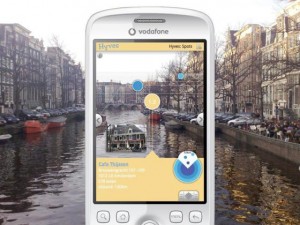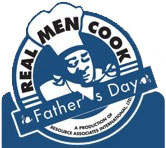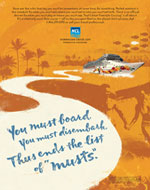Game On
Augmented reality (AR) is a developing technology that overlays computer-generated graphics onto a real image or video. The most popular example of AR is the yellow First Down line on televised football games. We’ve also seen it in rotating billboard displays on soccer and baseball, and briefly, the trailing comet tail to help hockey fans keep their eye on the puck.
Zugara, an interactive agency, experimented with online augmented reality in a couple notable online applications. The Webcam Social Shopper is a virtual fitting room that lets people see themselves in clothing before they buy. It also uses motion capture so a person can navigate the online store by moving their hands rather than stepping up to the keyboard.
They followed up with Cannonballz, a game utilizing a person’s web camera and Facebook Connect so the player becomes part of the action.
Oddcast has a simple AR demo. Just print the unique badge and display it in front of your webcam to bring an animated rocker to life. SekaiCamera is making strides in mobile AR as well; this video from LOEWE Tokyo offers a glimpse.
Location-Based Social Captioning
 Layar is a Dutch-made program that enables people to leave comments on images captured by their mobile device. The app uses 3D technology to gauge distances as well as the phone’s compass and GPS or cell tower triangulation. Then, computing all this information on the fly, the real image can be geotargeted so that other people can read the comments and post their own.
Layar is a Dutch-made program that enables people to leave comments on images captured by their mobile device. The app uses 3D technology to gauge distances as well as the phone’s compass and GPS or cell tower triangulation. Then, computing all this information on the fly, the real image can be geotargeted so that other people can read the comments and post their own.
People have already demonstrated a desire to share their opinions specifically. Check the level of user engagement in places like Viddler in-play video comments, Yelp reviews and the tips, reviews & crowdsourcing features of contextual location-based apps like FourSquare, Gowalla, BrightKite, Navizon and Waze.
Social captioning seems like a natural evolution of AR. With advanced filtering and administrative control, I can imagine a number of recreational and commercial uses for this kind of application.
- Ratings & reviews Restaurants, bars, local retail
- Visitor attractions City walking tours, Architectural and historical tours, ghost & event tours, sports & convert venues
- Real estate Listings, property details and contact info
- Scavenger hunts For fun & education, geocaching
- Amusement parks Maps, games and awards
- Convention exhibition Product interaction, marketing challenges
- Product testing & consumer feedback Large area or ticket items
- TV/Film Scene caption games, reviews
- Municipal services Emergency response, crime scene investigations, water & gas line mapping
- And more… Education, healthcare, transportation, shipping, traffic & weather, social communities, I could go on.
Layar recently won the Vodafone Mobile Clicks start-up challenge with a €75.000 prize. Here is the presentation they used in their pitch.
To see who is experimenting and applying augmented reality to the real world, visit the AR Consortium.











